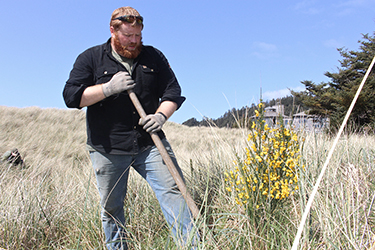|
Subscribe / Renew |
|
|
Contact Us |
|
| ► Subscribe to our Free Weekly Newsletter | |
| home | Welcome, sign in or click here to subscribe. | login |
Environment
| |
May 5, 2015
Scotch broom fight goes on and on and on
The Daily Astorian
CANNON BEACH, Ore. — It takes trained eyes and hours of tedious physical labor to prevent Scotch broom — the invasive European shrub that sprouts golden yellow flowers and produces thousands of seeds — from overrunning the sand dunes west of Chapman Point.
But, during the last 13 years, the Chapman Point Homeowners Association has hired local contractors to scale back the noxious, colonizing species to a level that is increasingly manageable from year to year, according to Ken McQuhae, a Chapman Point homeowner. For a time, McQuhae himself pulled out the plants with the help of a paid assistant.
Earlier this month, David Snodgrass, president and co-owner of Dennis' 7 Dees Landscaping & Garden Centers, and his three-man crew took their shovels out to the dunes and spent approximately 100 hours uprooting the Scotch broom from the sandy soil and hauling it away. They also scoured strips of land on the east side of Oak Street.
The four men — Snodgrass; Dave Santos, the landscape foreman; and two crew members — covered about 21 acres of affected area, from Chapman Point to the Breakers Point subdivision boundary.
In all the years of annual Scotch broom removal, this is the quickest Chapman Point has been able to finish the job, said Snodgrass, a Chapman Point homeowner.
He figures that the record is the result of the thorough work he and his team did last year, their first shot at the project.
If keeping Scotch broom in check was just a matter of spotting the bright yellow blooms and plucking the shrub from the earth, then that would be one thing.
But, because landscapers want to pull the broom before the plants blossom and scatter their seeds — which usually happens in mid-summer — many of the targeted plants are still relatively small, green and blend into their environment.
“When it's flowering, it's easy, but they're not always flowering all at the same time,” Snodgrass said. “So you really need to be able to see the little foliage amongst the dune grass.”
What's more, the Scotch broom, which elk like to munch on, is competing with at least 100 different types of vegetation, he said.
“You don't really see it until you get right up on it,” said Santos, who worked on the project last year.
However, winter on the North Coast was so mild this year that “the plants are about six weeks ahead of where they would be in a difficult year,” Snodgrass said, so the 7 Dees crew did their work a few weeks earlier than normal.
“We're trying to stay ahead of it,” he said. “We don't want the seeds to spread.”
Even after spreading, Scotch broom seeds can lie dormant for many years — 50 or more, McQuhae said — before they germinate, so landscapers may not know until years after a project how well they did, Snodgrass said.
When the homeowners association began the annual Scotch broom maintenance program back in 2003, the Scotch broom in the affected area was huge, “standing 10 feet or so,” said McQuhae, who organizes the Scotch broom eradication and thereby earned the nickname “The Broom Master.”
The trail from the Chapman Point subdivision to the beach was basically a tunnel through the broom's woody foliage, he said.
“It's a shrub that will mature into something more than a shrub,” said Snodgrass, also a Chapman Point homeowner. “It can really get big if let go unchecked.”
Scotch broom, which can be seen all along the Oregon Coast from U.S. Highway 101, is “extremely aggressive, and it will just crowd everything else out,” Lawson said.
Once the plant takes root in an area, “it spreads like wildfire,” Snodgrass said. “If we let it go for a couple of years, it would again get out of hand.”
Last year, Snodgrass thought he and his crew got rid of it all, but “it fooled me,” he said. “You need to stay after this, ongoing, to interrupt that natural progression of new plants.”
Though his task is Sisyphean, Snodgrass takes pride in protecting Chapman Point's oceanfront vista.
“I definitely get a sense of enjoyment and satisfaction out of doing it,” he said. “I'm hoping that the neighborhood and the tourists all appreciate the efforts that are being done here, because it really does benefit everybody.”
If the Chapman Point Homeowners Association will have him back, Snodgrass plans to take up the job again next year. “So I may be ‘The Broom Master' at some point,” he said, smiling.



